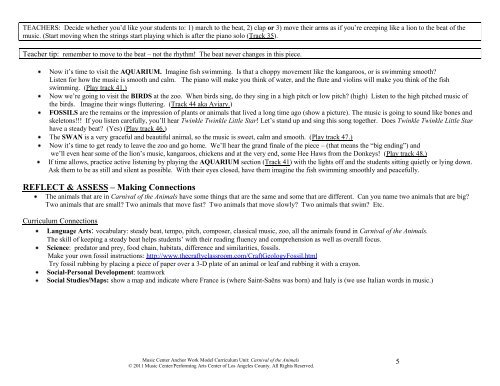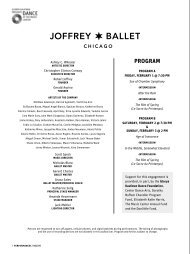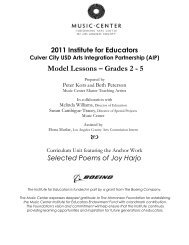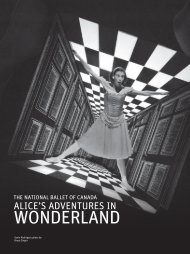Carnival of the Animals - Music Center
Carnival of the Animals - Music Center
Carnival of the Animals - Music Center
You also want an ePaper? Increase the reach of your titles
YUMPU automatically turns print PDFs into web optimized ePapers that Google loves.
TEACHERS: Decide whe<strong>the</strong>r you‟d like your students to: 1) march to <strong>the</strong> beat, 2) clap or 3) move <strong>the</strong>ir arms as if you‟re creeping like a lion to <strong>the</strong> beat <strong>of</strong> <strong>the</strong><br />
music. (Start moving when <strong>the</strong> strings start playing which is after <strong>the</strong> piano solo (Track 35).<br />
Teacher tip: remember to move to <strong>the</strong> beat – not <strong>the</strong> rhythm! The beat never changes in this piece.<br />
Now it‟s time to visit <strong>the</strong> AQUARIUM. Imagine fish swimming. Is that a choppy movement like <strong>the</strong> kangaroos, or is swimming smooth?<br />
Listen for how <strong>the</strong> music is smooth and calm. The piano will make you think <strong>of</strong> water, and <strong>the</strong> flute and violins will make you think <strong>of</strong> <strong>the</strong> fish<br />
swimming. (Play track 41.)<br />
Now we‟re going to visit <strong>the</strong> BIRDS at <strong>the</strong> zoo. When birds sing, do <strong>the</strong>y sing in a high pitch or low pitch? (high) Listen to <strong>the</strong> high pitched music <strong>of</strong><br />
<strong>the</strong> birds. Imagine <strong>the</strong>ir wings fluttering. (Track 44 aka Aviary.)<br />
FOSSILS are <strong>the</strong> remains or <strong>the</strong> impression <strong>of</strong> plants or animals that lived a long time ago (show a picture). The music is going to sound like bones and<br />
skeletons!!! If you listen carefully, you‟ll hear Twinkle Twinkle Little Star! Let‟s stand up and sing this song toge<strong>the</strong>r. Does Twinkle Twinkle Little Star<br />
have a steady beat? (Yes) (Play track 46.)<br />
The SWAN is a very graceful and beautiful animal, so <strong>the</strong> music is sweet, calm and smooth. (Play track 47.)<br />
Now it‟s time to get ready to leave <strong>the</strong> zoo and go home. We‟ll hear <strong>the</strong> grand finale <strong>of</strong> <strong>the</strong> piece – (that means <strong>the</strong> “big ending”) and<br />
we‟ll even hear some <strong>of</strong> <strong>the</strong> lion‟s music, kangaroos, chickens and at <strong>the</strong> very end, some Hee Haws from <strong>the</strong> Donkeys! (Play track 48.)<br />
If time allows, practice active listening by playing <strong>the</strong> AQUARIUM section (Track 41) with <strong>the</strong> lights <strong>of</strong>f and <strong>the</strong> students sitting quietly or lying down.<br />
Ask <strong>the</strong>m to be as still and silent as possible. With <strong>the</strong>ir eyes closed, have <strong>the</strong>m imagine <strong>the</strong> fish swimming smoothly and peacefully.<br />
REFLECT & ASSESS – Making Connections<br />
The animals that are in <strong>Carnival</strong> <strong>of</strong> <strong>the</strong> <strong>Animals</strong> have some things that are <strong>the</strong> same and some that are different. Can you name two animals that are big?<br />
Two animals that are small? Two animals that move fast? Two animals that move slowly? Two animals that swim? Etc.<br />
Curriculum Connections<br />
Language Arts: vocabulary: steady beat, tempo, pitch, composer, classical music, zoo, all <strong>the</strong> animals found in <strong>Carnival</strong> <strong>of</strong> <strong>the</strong> <strong>Animals</strong>.<br />
The skill <strong>of</strong> keeping a steady beat helps students‟ with <strong>the</strong>ir reading fluency and comprehension as well as overall focus.<br />
Science: predator and prey, food chain, habitats, difference and similarities, fossils.<br />
Make your own fossil instructions: http://www.<strong>the</strong>craftyclassroom.com/CraftGeologyFossil.html<br />
Try fossil rubbing by placing a piece <strong>of</strong> paper over a 3-D plate <strong>of</strong> an animal or leaf and rubbing it with a crayon.<br />
Social-Personal Development: teamwork<br />
Social Studies/Maps: show a map and indicate where France is (where Saint-Saëns was born) and Italy is (we use Italian words in music.)<br />
<strong>Music</strong> <strong>Center</strong> Anchor Work Model Curriculum Unit: <strong>Carnival</strong> <strong>of</strong> <strong>the</strong> <strong>Animals</strong><br />
© 2011 <strong>Music</strong> <strong>Center</strong>/Performing Arts <strong>Center</strong> <strong>of</strong> Los Angeles County. All Rights Reserved.<br />
5






